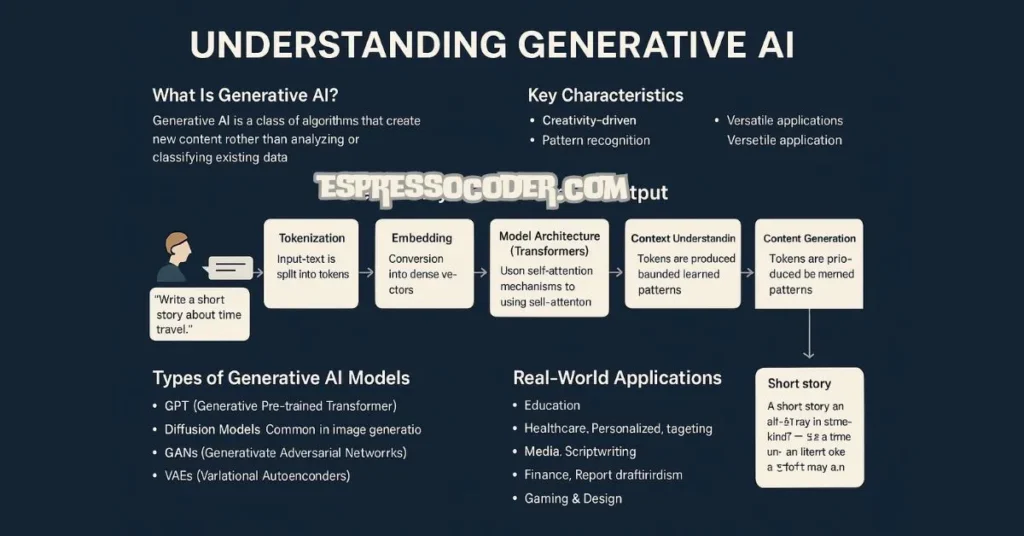Generative AI has rapidly transformed how humans interact with machines. From
producing entire essays to generating photorealistic images or functional code, this
technology is redefining creativity, productivity, and automation. What sets it apart is its
ability to produce new content rather than merely process existing data. As industries
adapt to this new paradigm, the curiosity around how generative AI tools operate behind
the scenes is at an all-time high.
This detailed article unpacks the inner workings of Generative AI, starting from a simple
prompt to the final AI-generated output. It also examines the major models involved, key
applications, required skills, and ethical considerations. For learners and professionals
eager to understand this space, Generative AI is proving instrumental in bridging the
knowledge gap.
Contents
Introduction
The surge in interest around artificial intelligence has led to the rapid adoption of tools
that can generate human-like content. Among these innovations, Generative AI stands
out due to its ability to generate new data in various forms, including text, images,
audio, and code. Individuals and professionals alike are eager to understand how these
tools work, and many are turning to Generative AI courses to gain practical insights.
But what exactly happens behind the scenes when we input a prompt into tools like
ChatGPT, DALL·E, or Midjourney? This article provides a detailed examination of the
internal mechanisms of Generative AI, beginning with the user-generated prompt and
concluding with the intelligent output. Understanding these systems enables learners to
maximise their use of tools and align their skills with future industry needs.
What Is Generative AI?
Generative AI refers to a class of algorithms that create new content rather than merely
analysing or classifying existing data. It leverages large-scale machine learning models,
intensive learning, and transformer architectures to understand complex patterns in data
and produce outputs that resemble human creativity.
Key Characteristics
● Creativity-driven: Capable of producing novel content.
● Pattern recognition: Learns from massive datasets to identify and replicate
structures.
● Versatile applications: Used in text generation, image synthesis, music
composition, and more.
The Journey From Prompt to Output
When a user enters a prompt, such as “Write a short story about time travel,” into a
GenAI system, a sequence of highly technical processes takes place. Here’s a
breakdown of how that prompt gets transformed into meaningful content:
- Tokenisation
● The input text is split into tokens small units like words or subwords.
● These tokens are mapped to numerical vectors that the model can process. - Embedding
● Tokens are converted into dense vectors, known as embeddings.
● These embeddings capture semantic information about the input text. - Model Architecture (Transformers)
● Most Generative AI tools are built on transformer models, such as GPT
(Generative Pre-trained Transformer).
● Transformers utilise self-attention mechanisms to assess the significance of each
word within its context.
● This enables the model to comprehend not only meaning but also nuance, tone,
and relationships. - Context Understanding
● The model processes the entire prompt using multiple layers to build contextual
awareness.
● Earlier layers detect syntax and grammar; deeper layers grasp complex
meanings and intent. - Content Generation
● The model generates one token at a time based on probability distributions.
● Each new token is influenced by previous tokens and the learned data patterns.
● This process continues until the model determines the content is complete or
reaches a token limit. - Post-Processing
● Some tools apply filters or ranking mechanisms to refine the output.
● Final content is formatted and delivered to the user in a coherent structure.
Types of Generative AI Models
Several models underpin the generative AI ecosystem. Here are the most influential
ones:
- GPT (Generative Pre-trained Transformer)
● Used primarily for natural language tasks.
● Learns from large text corpora and fine-tunes for specific applications. - Diffusion Models
● Common in image generation (e.g., DALL·E, Midjourney).
● Gradually denoise a random pattern to form a realistic image. - GANs (Generative Adversarial Networks)
● Used in deepfake technology and high-fidelity image synthesis.
● Involve two networks (generator and discriminator) competing to improve
realism. - VAEs (Variational Autoencoders)
● Often used in generative design and pattern discovery.
● Capable of learning latent representations for generating variations of data.
Real-World Applications
Generative AI is already transforming multiple sectors, including:
● Education: Personalised tutoring, content generation, adaptive learning paths
● Healthcare: Synthetic medical data generation, diagnostics support
● Media: Scriptwriting, content ideation, automated journalism
● Finance: Report drafting, predictive modelling, customer service automation
● Gaming & Design: Character design, procedural content generation
Benefits of Understanding Generative AI Internals
Learning how generative models work helps users:
● Craft more precise and effective prompts
● Customise outputs for specific goals
● Troubleshoot and refine AI-generated content
● Build or fine-tune their own lightweight models for niche applications
This technical awareness is especially important as AI integration becomes a standard
in many job roles.
Skills Required to Work with Generative AI
Whether you’re an aspiring developer, educator, or business analyst, certain
foundational skills are essential:
● Basic Python programming
● Understanding of neural networks
● Familiarity with natural language processing (NLP)
● Prompt engineering basics
● Data preprocessing and handling
● Ethical considerations and bias mitigation
Many of these are covered in leading online programs and tutorials, which often feature
hands-on labs and real-world projects to accelerate learning.
Challenges and Considerations
Despite its power, Generative AI comes with certain limitations and risks:
● Bias in training data: Can lead to skewed or inappropriate outputs
● Overreliance on AI: May hinder original thinking if misused
● Misinformation: Generated content may appear factual but be incorrect
● Data privacy: Potential for misuse of sensitive information
Understanding these challenges helps in adopting responsible AI practices.
Conclusion
As industries continue to embrace artificial intelligence, the demand for talent that
understands the inner workings of Generative AI will only grow. Knowing what happens
between a prompt and a polished output is no longer optional; it’s essential for anyone
serious about leveraging these tools professionally.
Those seeking to enhance their capabilities are increasingly exploring the Best Gen AI
courses to gain hands-on experience with model architecture, prompt design, and
real-world application.
By combining foundational knowledge with practical training, individuals can not only
utilise Generative AI tools more effectively but also contribute to the development of
more ethical, accurate, and innovative AI systems for the future.

